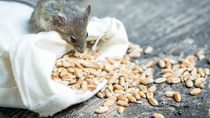Nowhere to hide: New approach in animal production rodent control

With rodent populations in rural areas booming, animal producers are taking to herbicide action plans alongside traditional baiting in a strategic bid to prevent the risk of feed contamination and spread of disease while securing electrical assets and water systems.
Rural areas are the target of hordes of mice again this year with farmers being warned to plan preventative pest control to secure their yields and protect property.
Each year, rodents destroy approximately 20 percent of the world’s agricultural products, cause enormous amounts of damage to homes and businesses, and spread more than 200 human pathogens1.
With recent reports of high mice activity in Victoria and South Australia, after the wettest summer in almost 80 years, rural areas are struggling to contain rodent populations that if not caught early are multiplying rapidly, in some instances pooling to create square meters of carpet like coverage.
Jonothon Doubleday, Director of CCD Animal Health says “farmers were aware of the threat of an increase in the mice population potentially happening and wanted to adapt their existing program accordingly.”
He says that while the outbreak may not have been as bad as early predictions, the critters have been spotted in high numbers dues to feed availability and environmental conditions.
“We’ve seen a significant increase in numbers of mice in and around animal housing, feed and packing sheds resulting in farmers adapting baiting programs accordingly to reduce numbers, where they were using a maintenance program” he added.
Mr Doubleday also said that herbicides are becoming increasingly important in pest control plans to control growth “in between animal housing and around storage sheds as well as clean up any areas where mice or rats can seek shelter”.
Provider of specialty pest solutions, BASF says a comprehensive approach to pest management can be a cost-effective strategy in the long run for farmers, preventing the catastrophic effects that pests can have on health, buildings and assets and the environment.
“In recent years the intensive farming market has taken steps to prevent rodent outbreaks by having an ongoing rodent management program with baiting programs targeted on key areas within and around sheds, grain/feed storage areas and most importantly a first line of defense set with perimeter fence line baiting,” explained Dr. David Elmouttie, Technical Specialist for BASF Professional and Specialty Solutions
“Broadacre & horticultural farmers can also develop long-term rodent management programs by implementing vegetation and weed management strategies year round in both adjacent and crop areas. BASF’s herbicide solutions can be utilised to manage weedy, grassy areas, around and within crops which has multiple benefits. Effective weed management can help to prevent the creation of conducive rodent conditions (essential for population build up) long before mouse plagues are even noticed or considered likely. Unfortunately, this type of vegetation management is often not thought of as a pest preventative measure,” explained Dr. Elmouttie.
“BASF also has an extensive range of rodenticides to protect stored crops and farm areas once rodent numbers do increase. This includes the Storm range of rodenticides products specifically designed for use in and around storage and farm buildings to the revolutionary Selontra which is approved for use in a range of situations including along fence lines, providing effective management from paddock all the way through to harvest and securing commodities,” Dr Elmouttie added.
“Now that there is a product registered perimeter baiting, it gives farmers the opportunity to extend the areas of baiting and reduce the challenge to the animal houses and feed sheds,” Mr Doubleday added.
1http://www.pestworld.org/request-media-access/pest-facts/?category=3774&type=-1